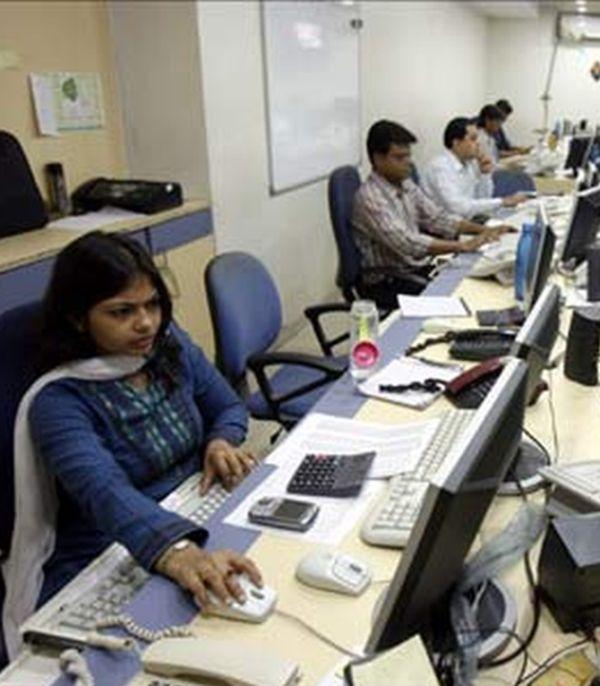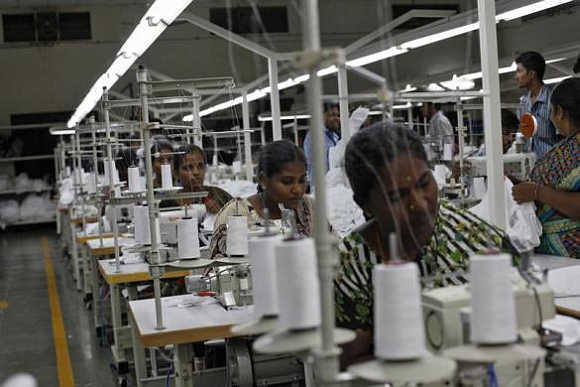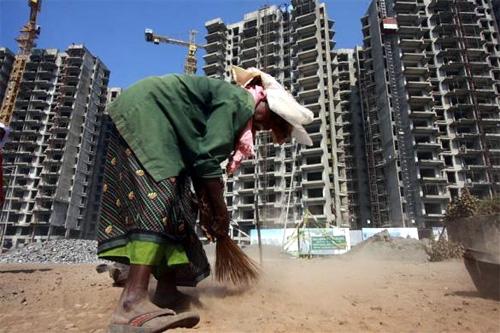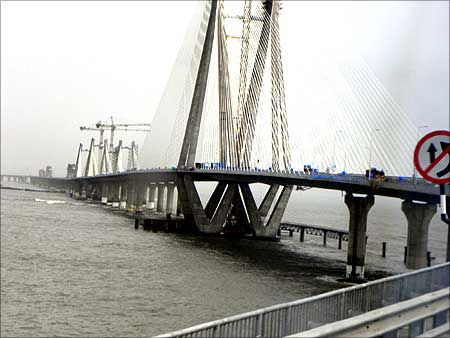Photographs: Punit Paranjepe/Reuters
The answer may lie in harnessing the small and medium enterprises rather than focusing on labour-intensive manufacturing, says Rajiv Lall.
I have argued in the past that it is unrealistic for a variety of reasons to expect India to create mass employment in the manufacturing sector along the lines of our east Asian neighbours.
And although agriculture today, still accommodates 52 per cent of our 480 million-strong labour force, its future absorptive capacity is limited. So, where will the jobs come from?
The challenge we face is not just the number of jobs that must be created, but also the quality of jobs.
The fear is that labour displaced from agriculture will have no option but to join a growing pool of marginalised workers in low-productivity service sector jobs.
The conventional view on job creation is that formal and organised is good and unorganised is bad.
The fact that the bulk of our non-agricultural workforce is employed in the unorganised sector, in the sense that they are self-employed or employed in casual jobs without social protection, is thus seen as problematic.
This needs to be examined more closely.
Click NEXT for more...
Small and medium enterprises will create maximum jobs
Image: Currently, manufacturing units employ staff in large numbers.Photographs: Vijay Mathur/Reuters
There is a difference between “unorganised” and “informal”. The informal sector is a flexible and often seasonal or cyclical buffer that absorbs the ebb and flow of the underemployed.
This is not the type of job creation we want. The unorganised sector is quite different.
These companies maybe unregistered, outside the purview of the tax system, and may not offer social protection, but, in fact, they do generate regular and gainful employment opportunities.
A very significant portion of our labour force that is recorded as unorganised is employed in the micro, small and medium enterprises (MSMEs). For the purpose of eligibility to government schemes and priority sector lending by the banks, MSMEs are defined as enterprises that have investment in plant and machinery that is less than Rs 5-10 crore Rs 50-100 million), depending on whether the enterprise is in the service or the manufacturing sector.
Less than five per cent of MSMEs are formally registered1, but they all have a legal form.
Click NEXT for more...
Small and medium enterprises will create maximum jobs
Image: Sectors like textile, food and beverages have a strong workforce.Photographs: Mansi thapliya/Reuters
Almost 95 per cent of MSMEs are organised as sole proprietorships (rather than private or public limited companies or partnerships).
In 2006-07, the most recent year for which survey data is available2, there were 36 million MSMEs in the country employing an estimated 80.5 million people or about 37 per cent of the non-agricultural workforce in non-casual jobs.
The Government of India estimated that by 2011-12, the total number of MSMEs had grown to 45 million, employing about 100 million people or 43 per cent of the country’s non-agricultural workforce and contributing the equivalent of eight per cent of gross domestic product (GDP).
Over 40 per cent of these MSMEs are owned by entrepreneurs from other backward castes. Another 10 per cent are now owned by scheduled castes and scheduled tribess.
More than 55 per cent of MSMEs are located in rural India. Not surprisingly, most MSMEs are engaged in service sector activities. An estimated 30 million MSMEs are in activities such as the retail trade, repair of household goods, motor vehicles and motor cycles, hotels and restaurants, education and so on.
These are typically tiny enterprises that generate an estimated 60 million jobs for mostly self-employed entrepreneurs.
There are roughly 15 million MSMEs that are in manufacturing. Individually, these tend to be larger in size.
They employ the equivalent of 80 per cent of the country’s entire manufacturing labour force or an estimated 40-odd million people directly in sectors such as garment manufacturing, textiles, leather goods, furniture making and food and beverages.
Click NEXT for more...
Small and medium enterprises will create maximum jobs
Image: SME's contribute around 45 per cent output to the total GDP.Photographs: Ahmad Masood/Reuters
MSMEs are thus emerging as essentially entrepreneur-owned and operated entities that individually may be very small and unregistered, but overall, they are very significant contributors to gainful employment, especially in the service sector.
There is, however, a nuance here. There is a stark difference in the productivity levels of manufacturing and non-manufacturing segments of the MSME universe.
Manufacturing MSMEs account for more than 90 per cent of MSMEs’ overall contribution to GDP or the remarkable equivalent of 45 per cent of the country’s gross industrial output and 40 per cent of the country’s total exports4 in part by embedding themselves in local and global supply chain networks.
Clearly, manufacturing MSMEs have been creating better quality jobs than service sector MSMEs.
But that said, the entire MSME sector, including both its manufacturing and services segments, needs to be nurtured.
These enterprises are a very valuable if not critical engine for the creation of higher quality jobs.
...
Small and medium enterprises will create maximum jobs
Image: Due to a general slowdown, realty sector may not be able to provide that many jobs.Photographs: Reuters
Beyond MSMEs, the construction industry is an extremely important potential job creator.
According to the Planning Commission, construction generates 50 million jobs or about one-fifth of all non-agricultural employment in the country.
Unlike the MSME sector, employment in the construction industry is, however, largely informal. Today, it attracts migrant workers looking for seasonal jobs.
But this is likely to change in the coming years. As the pace of urbanisation picks up, construction-led job creation is likely to see sustained growth.
There is tremendous scope for improving the quality of construction in the country, which if we are able to do, will create a dynamic pipeline of decent new jobs in the decades to come.
Construction will not be about creating jobs for transient labour. It will be about creating jobs not only for civil engineers, but also for qualified masons, carpenters, electricians, and so on.
Click NEXT for more...
Small and medium enterprises will create maximum jobs
Image: There will be jobs only if mega infra projects come up for construction.Photographs: Dominic Xavier/Rediff
And this is not just about constructing houses and office buildings, it is about building critical infrastructure such as power plants, transportation networks in the form of roads, metros, airports, railways and so on.
A much-needed revival of investment in infrastructure will do wonders for sustained job creation in construction.
Further, there is no reason why the services sector beyond the existing footprint of MSMEs cannot generate better quality employment opportunities at scale.
As our GDP per capita grows, spending on health care, education, and consumption will continue to see secular growth.
There is an extreme shortage not just of doctors, but of appropriately qualified health care professionals.
The education business will require not just school teachers, but a whole ecosystem of jobs to improve the quality of educational outcomes.
A modernising retail industry will have to see massive growth in points of sale and supporting supply chain infrastructure.








article